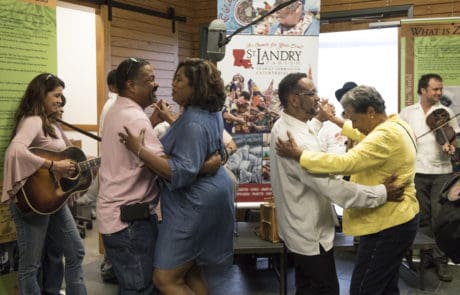Cajun Spirit. Creole Soul. – A Brief History of St. Landry Parish
Mary Hawkins2025-02-26T14:34:00-06:00“St. Landry Parish, Louisiana is a place with Cajun spirit and Creole soul.”
Thumb through any St. Landry Parish phone book and you’ll see surnames that indicate a gumbo of ethnicities – French, Spanish, German, African, Irish, Native American and more, but many residents also celebrate their Cajun and Creole heritage.
Cajuns are descendants of the Acadians, who were evicted from the region of Nova Scotia in the mid-1700s, after their continued refusal to swear allegiance to the British crown. Many of these Acadian exiles landed in south Louisiana, where they blended with other groups to have a lasting impact on the state’s language, music, and food.
Creole is broadly defined and has numerous definitions that vary in different regions of the state, country and the world. In St. Landry Parish, many Creoles identify themselves as the descendants of slaves and free people of color. Many trace their lineage to the Caribbean and Africa and even speak in Creole.
Creoles have heavily influenced the region’s culture, especially with zydeco, the accordion-driven, dance music that now has fans across the globe. Accordionist Amédé Ardoin, a native Creole of St. Landry Parish, is widely regarded as a founding father of Cajun music and zydeco.

Creole Heritage Folklife Center in Opelousas, Louisiana
Today, both cultures are celebrated at festivals, music events, and local attractions. In Opelousas, you can learn more about Creole Louisiana at the Creole Heritage Folklife Center. The center is run by cultural icon, Rebecca Henry, who is a native folklorist and herbalist. At the center, she provides tours and workshops in either English or Creole and offers educational youth programs throughout the year.
For a taste of Cajun culture visit the Jean Lafitte National Park Prairie Acadiana Culture Center. Practice your French skills on Wednesday mornings at La Table Française de Eunice in the Eunice Depot Museum. Coffee, snacks, and good company are in store. Nearby is the Liberty Theatre where the Rendez-vous des Cajuns live radio show would air. This long-running tradition now showcased Cajun, Creole, and zydeco music artists. Locals music artist, Steve Riley, often hosted special shows at the Liberty such at the Cajun Fiddle Kings or the Creole Accordion Kings. Efforts are underway to reopen the Liberty and you can read about them here.
For more Cajun and Creole cultural events, see below!
Lebeau Zydeco Festival – Lebeau is the birthplace of music legend, Rockin’ Sidney, and one of Louisiana oldest zydeco music festivals.
Original Southwest Louisiana Zydeco Music Festival – Every zydeco fan should experience the Southwest Louisiana Zydeco Music Festival. For over 35 years the festival has featured non-stop, best of the best zydeco musicians.
Holy Ghost Creole Festival – This festival celebrates everything Creole, from A to Z. Find homecooked Creole food, handmade sweet dough pies, and live zydeco and gospel music.
Find French-Friendly Events – From French tables to jam sessions and concerts, there are plenty ways to practice your Cajun or Creole in St. Landry Parish.














